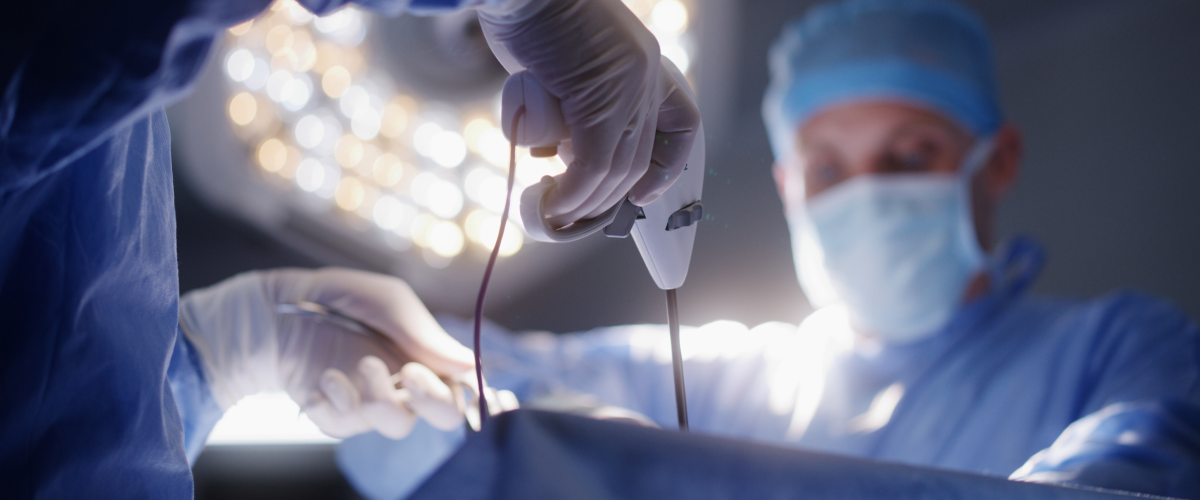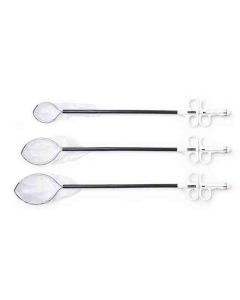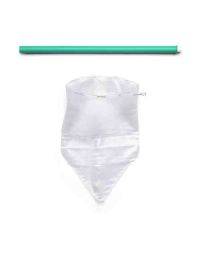The surge in surgeries over the past years can be attributed to an elevated incidence of cancers and obesity, which are often associated with gastroenterology, gynaecology, or urology.¹ Many of these conditions can be effectively treated or diagnosed using laparotomy or laparoscopic techniques. In turn, this trend has significantly increased the demand for laparoscopic procedures across Europe and worldwide. The preference for laparoscopic techniques is particularly advantageous in cases involving obesity2 or cancer, particularly endometrial cancer,3,4 because it allows for precise and minimally invasive procedures. This helps with reducing the risks associated with traditional open surgeries.
This shift towards laparoscopy mirrors a broader trend in modern surgical practice, emphasising less invasive and more advanced approaches, as healthcare systems prioritise efficiency, patient outcomes, and cost-effectiveness.
What is the difference between laparotomy and laparoscopy?
The main difference between laparotomy and laparoscopy lies in the surgical approach and level of invasiveness. Laparotomy involves making a surgical incision, typically around 15 to 25 cm-long (about 9.84 inches) into the abdominal cavity. The incision allows the surgeon to access the organs and could be used for diagnostic purposes or major procedure preparation. This technique is invasive from a patient's point of view, as the likelihood of developing scars after the surgery is high and the risk of complications increases with the size of the incision.1
Since the 1900s, however, a new technique emerged in the operating theatre called laparoscopy or minimally invasive surgery. This surgical procedure involves making smaller incisions into the abdominal cavity, using a camera to visualise the inside of the abdomen. Unlike laparotomy, which requires a single large incision, laparoscopy achieves the same surgical goals with smaller incisions.6
Why is laparoscopy increasingly chosen over laparotomy by surgeons?
- Decreased risk of complications: The use of minimally invasive techniques has been shown to reduce the risk of bleeding and intraoperative complications. This translates to reduced discomfort for the patient during post-operative rehabilitation.7
- Turnover in operating theatre: In many cases, conversion from laparotomy to laparoscopy leads to shorter operating times. This practice optimises the use of the operating theatre, benefiting hospitals by maximising the efficiency of time spent in surgery.8
- Reduced stay in hospitals: Laparoscopic procedures result in shorter hospital stays post surgery, leading to overall cost reductions, compared to the laparotomy approach.9,10,11
- Advancements in technology: Continuous advancements in laparoscopic instruments, imaging technologies, and surgical techniques have made laparoscopy increasingly feasible for a wider range of surgical procedures.12
- Better cosmetic outcome: Laparoscopy leaves smaller scars, resulting in improved cosmetic outcomes and higher patient satisfaction.13
How can Medline support your transition to laparoscopy in your practice?
Laparoscopy represents a significant advancement in the treatment of various pathologies, and can greatly improve how surgeons approach these conditions.
Despite the challenges associated with laparoscopic techniques, Medline is confident in its promising capabilities. This is reflected in our portfolio of laparoscopic instruments, tailored to meet all of your potential needs and help optimise the outcomes of laparoscopic procedures. Moreover, the products in our MED-LAP portfolio are sold by Medline’s operating room (OR) division as sterile products (eaches), or may be included in sterile procedure trays (SPTs).
Explore how Medline can empower your practice with the latest in laparoscopic technology. Visit the links below to explore our MED-LAP offerings and take the next step towards a future of advanced surgical innovation.


Laure Boulet
Product Manager, Europe
Laure, originally from France, holds a Master’s degree from ECE Engineering School, with a major in healthcare technology. She further pursued her studies at Sorbonne Université, obtaining a Master’s in Healthcare Engineering for Medical Devices. Based in Voisins (France), Laure manages Medline’s fluid management, drainage, and laparoscopy portfolios at the European level. Learn more on LinkedIn.


Florane Gréau
Junior Product Manager
Florane, a native of France, holds a Master’s in Biotechnology and Management, having specialised in Healthcare Product Management. She started her career with Medline Europe, previously as Junior Product Manager for the sterile procedure tray (SPT) division. Now based in Châteaubriant (France), she manages the personal protection & textiles portfolio as Junior Product Manager - Europe. Learn more on LinkedIn.
References:
1. Newman, R.K. (2023) Abdominal compartment Syndrome. https://www.ncbi.nlm.nih.gov/books/NBK430932/.
2. Kirkpatrick, A.W., Roberts, D.J., De Waele, J., Jaeschke, R., Malbrain, M.L.N.G., De Keulenaer, B., ... & Ball, C.G. (2013). Intra-abdominal hypertension and the abdominal compartment syndrome: updated consensus definitions and clinical practice guidelines from the World Society of the Abdominal Compartment Syndrome. Intensive Care Medicine, 39(7), 1190-1206.
3. Malbrain ML, Cheatham ML, Kirkpatrick A, Sugrue M, Parr M, De Waele J, Balogh Z, Leppäniemi A, Olvera C, Ivatury R, D'Amours S, Wendon J, Hillman K, Johansson K, Kolkman K, Wilmer A. Results from the International Conference of Experts on Intra-abdominal Hypertension and Abdominal Compartment Syndrome. I. Definitions. Intensive Care Med. 2006 Nov;32(11):1722-32. doi: 10.1007/s00134-006-0349-5. Epub 2006 Sep 12. PMID: 16967294.
4. Vidal MG, Ruiz Weisser J, Gonzalez F, Toro MA, Loudet C, Balasini C, Canales H, Reina R, Estenssoro E. Incidence and clinical effects of intra-abdominal hypertension in critically ill patients. Crit Care Med. 2008 Jun;36(6):1823-31. doi: 10.1097/CCM.0b013e31817c7a4d. PMID: 18520642.
5. National Center for Biotechnology Information. (2023). Laparotomy. Retrieved from URL: https://www.ncbi.nlm.nih.gov/books/NBK525961/
6. Admin, S. K. (2024, February 5). Comparison between Laparotomy & Laparascopy: Sri kota medical. Sri Kota Specialist Medical Centre. https://www.srikotamedical.com/the-difference-between-laparotomy-and-laparascopy/
7. Hogan B, Franklin B, O'Leary E, et al. (2022). Effectiveness of laparoscopic surgery compared to open surgery for acute appendicitis: A systematic review and meta-analysis. PLoS ONE, 17(2), e0274887. https://doi.org/10.1371/journal.pone.0274887
8. Gómez, E. J., Vargas, L. F., Lozada‐Martinez, I. D., Reyes, M., Pedraza, M., Forero, N., Guardo‐Carmona, D., & Narvaez‐Rojas, A. R. (2022). Laparoscopy has better performance than laparotomy in the treatment of stable penetrating abdominal trauma: A retrospective cross‐sectional study in a trauma referral hospital in Colombia. Health Science Reports, 5(3). https://doi.org/10.1002/hsr2.640
9. Kashyap L, Sharma D, Chintamani C, et al. Comparison of conventional open surgery and laparoscopy for mastectomy: A pilot study. World Journal of Surgical Oncology. 2009;7:83. https://pubmed.ncbi.nlm.nih.gov/19805679/
10. Walker JL, Piedmonte MR, Spirtos NM, et al. Laparoscopy compared with laparotomy for comprehensive surgical staging of uterine cancer: Gynecologic Oncology Group Study LAP2. Journal of Clinical Oncology. 2009;27(32):5331-5336. https://ascopubs.org/doi/10.1200/JCO.2009.22.3248
11. Alp İG, Ercan B, Yıldız T, Alp V, Tokocin M, Sözen S. Outcomes of open versus laparoscopic appendectomy for complicated appendicitis. Anticancer Research. 2014;34(5):2497-2500. https://ar.iiarjournals.org/content/34/5/2497
12. Buia, A., Stockhausen, F., & Hanisch, E. (2015). Laparoscopic surgery: A qualified systematic review. World Journal of Methodology, 5(4), 238-254. https://doi.org/10.5662/wjm.v5.i4.238
13. National Research Council. (2014). Review of the Department of Defense Enhanced Particulate Matter Surveillance Program Report 2010. Washington, DC: The National Academies Press. https://doi.org/10.17226/18912









